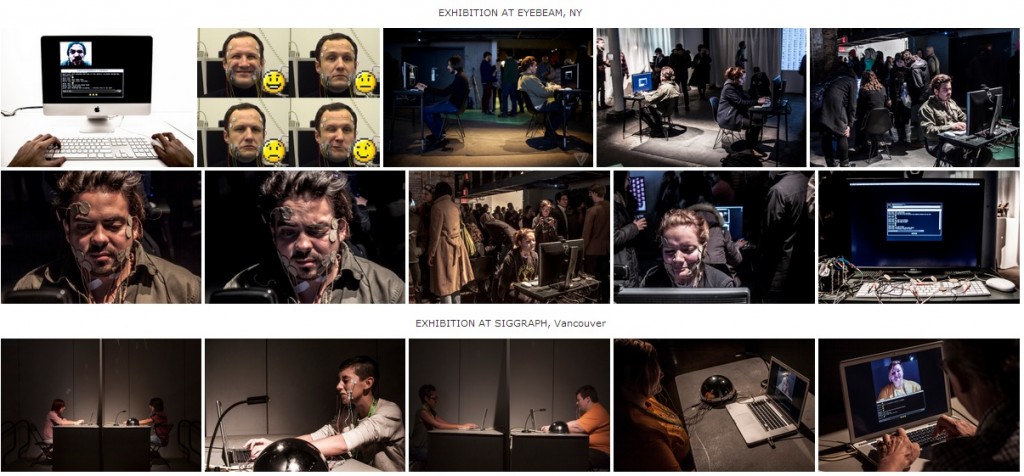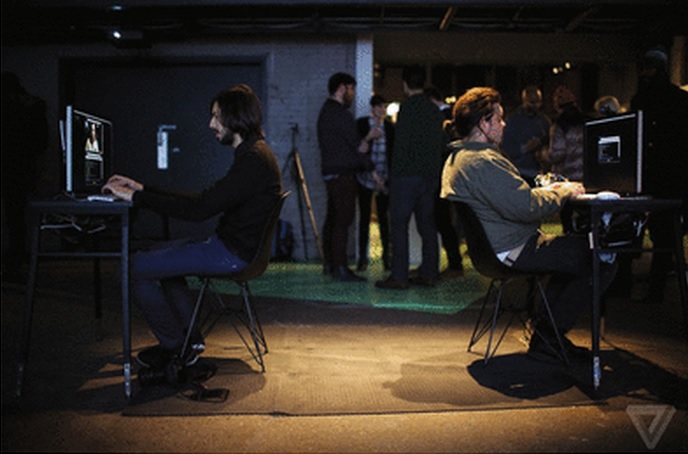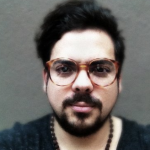



TRANSICONMORPHOSIS by Emilio Vavarella and fito_segrera. /// 2013. Installation. Variable dimensions
In TRANSICONMORPHOSIS, a conventional chat service hosted in a computer is interfaced (through a micro-controller) with a series of electrodes connected to the face of the artist; on the other side of the exhibition space another computer allows a member of the audience to chat with the artist. The system focuses on facial expressions, and translates the emoticon received through the chat into electrical impulses that force the artist’s facial features to mimic the expression of each emoticon.
TRANSICONMORPHOSIS is an interactive artwork that proposes an ambiguous and experimental communication system for the near future. As Nobel Prize Winner Elias Canetti wrote in the ’80s: “We know that the influence of a man on another is what determines incessant and fluctuating metamorphosis that occurs in gesture and facial expressions; when these are strictly prohibited, every metamorphosis becomes difficult and, in the end, impossible.” If in the future, the possibility of face-to-face communication becomes less widely used and written communication becomes crystallized in a series of immutable forms, humans will lose the empathic abilities that today are, in part, reproduced by emoji and emoticons. If humanity fails to invent new metamorphoses, and new emoji, devices such as TRANSICONMORPHOSIS will be diffused worldwide.
TRANSICONMORPHOSIS is the result of a theoretical reflection on the development of new forms of technological communication, their effects on human beings as well as their political effects. Modern communication systems could have condemned human beings to a life without fundamental elements such as smiles or kisses, pushing towards a cold and multi-mediated form of communication. Emoticons have a long history: they have introduced fundamental human expressions to new technologically mediated environments. They were adopted so quickly and widely that emoji can be considered one of the most successful social metamorphoses of the last ten years. Emoji maintain creativity and expressiveness in systems ruled by an ideology of efficiency and unambiguousness. Metamorphosis was considered by Canetti to be one of the biggest mysteries. In the notes he wrote before dying, he explained how it was the beginning of existence, what Power is afraid of, what art should always create, and what has been expressed – since the beginning of time – in humans’ dreams and myths. We can understand more about the connection between metamorphosis and emoji through the realization that they both share the elements that distinguish humans from machines: empathy, love, irony and art.
ARTICLE in LEONARDO
Exhibited at:
– (upcoming) ACTING IN TRANSLATION, at SIGGRAPH 2014, curated by Basak Senova, works selected by Barak Senova, (curator, Koç University), Mona Kasra (artist), Amit Zoran (Fluid Interfaces Group, MIT Media Lab), Kate Armstrong (curator), Cezanne Charles (artist), Mushon Zer-Aviv (media activist), Vancouver Convention Center, Canada
– EMOJI, Art & Design Show, (2013), curated by Fred Benenson (Kickstarter), Julia Kaganskiy (Arts & Technology Meetup), Mercedes Kraus (womanzine), Zeshan Malik & Dale Kim (Melee Media), Zoe Salditch (Eyebeam), Jenna Wortham (The New York Times), Will Zweigart (5Loom) and Kelly Reeves, Andrea Rosen & Lindsey Weber (Forced Meme Productions), Eyebeam Art and Technology Center, New York, USA




